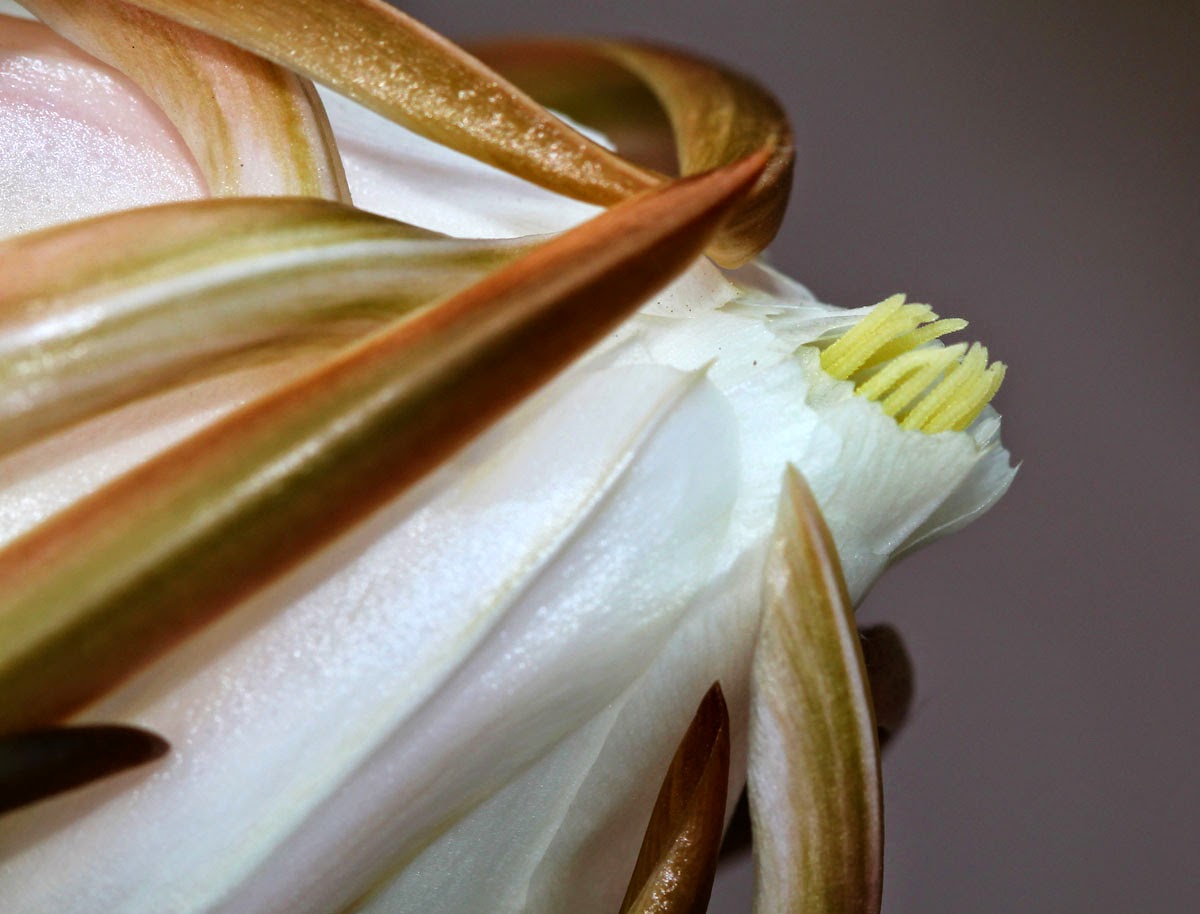 That next night I was running around with the cat feedings and immediately noticed the change. The huge bud was much changed from the above image. Not only was the front part much swollen, but the stigma part of the inner flower was protruding from the tip of the bloom, shown at right. So far, all these images are single-shots, taken with the 100mm Canon macro lens. But given the rapidly fading night, the need to shoot wider apertures, and given all I've learned about focus stacking to deepen the depth of field, it was time to get to work! I decided against trying to do a time-lapse video... I did that a couple years back with another variety of cereus, and while spectacular, I wanted to work more with focus stacking and higher magnifications...
That next night I was running around with the cat feedings and immediately noticed the change. The huge bud was much changed from the above image. Not only was the front part much swollen, but the stigma part of the inner flower was protruding from the tip of the bloom, shown at right. So far, all these images are single-shots, taken with the 100mm Canon macro lens. But given the rapidly fading night, the need to shoot wider apertures, and given all I've learned about focus stacking to deepen the depth of field, it was time to get to work! I decided against trying to do a time-lapse video... I did that a couple years back with another variety of cereus, and while spectacular, I wanted to work more with focus stacking and higher magnifications...I've talked about focus stacking before, and the results are quite incredible! In short, multiple images are taken with slight changes in focus between them. There is an easy-to-follow video tutorial link in my previous post that shows how to combine the sharp parts of each image in Photoshop that leads to incredible depth of field, if you want that sort of thing. Of course, sometimes you only want to keep the object of your interest in focus, but in macro shooting, generally you only have a very narrow depth of focus, so for subjects like a large flower in dim light, it is a natural! In the image at left, 8 frames with slight focus changes between are combined to keep nearly everything in focus while shooting straight down the flower... Taken moments after the shot above, it is a different perspective you wouldn't be able to get in a single shot (and have it all in focus).
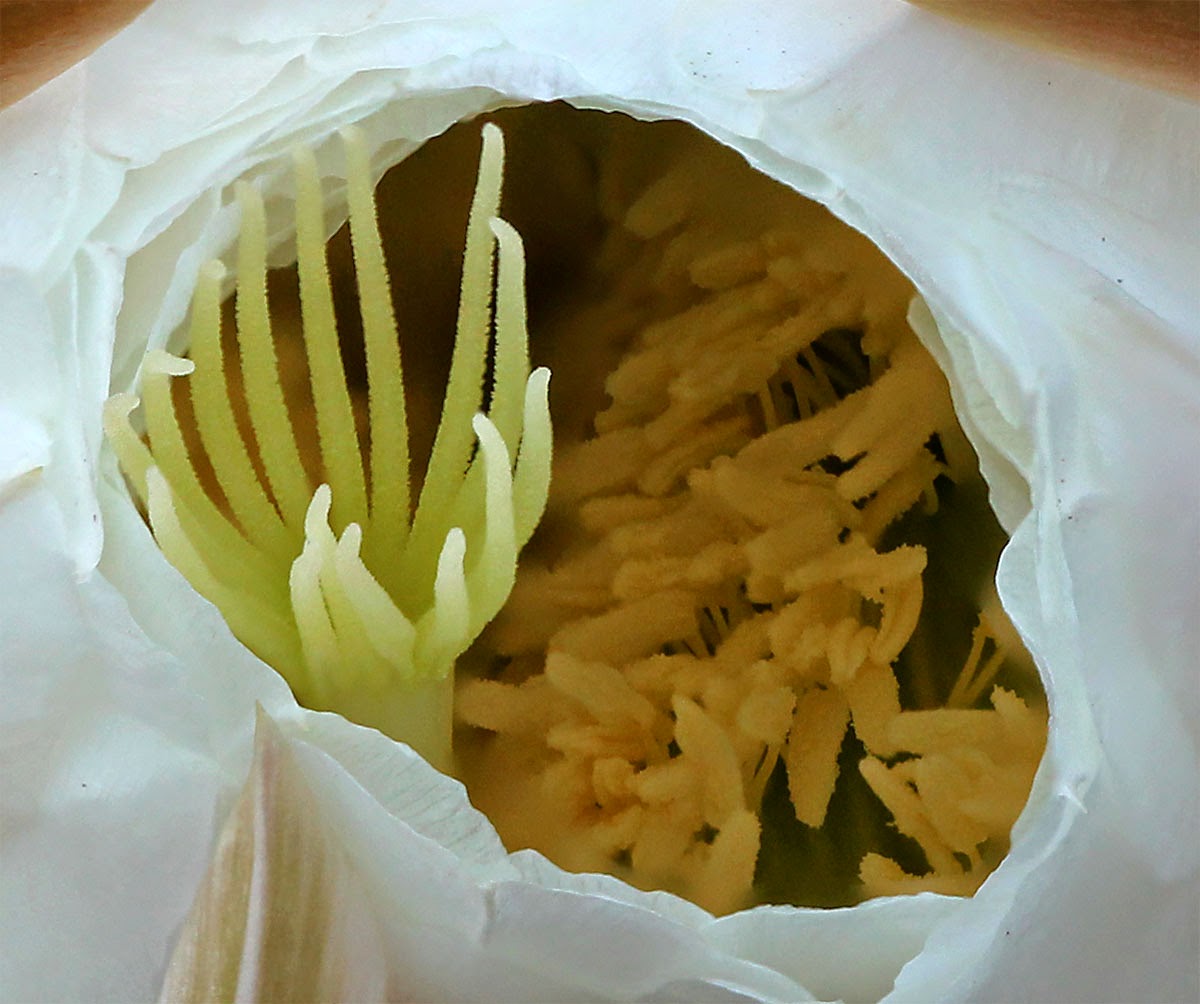 The bloom opens relatively quickly as the sun approaches the horizon. Less than 60 minutes later, the flower bloom finally opens to start to reveal the interior. At left is a 14-frame focus stack to keep all details in focus. As you can see, the depth of field is incredible! The stigma and sepals are a couple inches apart and otherwise couldn't be in focus at the same time. At right is a close-up of the same image, at nearly full camera resolution. While the detail is spectacular, note that there are some artifacts - particularly around the petal inner aperture. In the shots focused on the deep interior, the out-of-focus petals obscured part of the details and can be seen as a diffuse zone against the interior structure. But these artifacts are hardly objectionable - bet you didn't spot them before I pointed them out!
The bloom opens relatively quickly as the sun approaches the horizon. Less than 60 minutes later, the flower bloom finally opens to start to reveal the interior. At left is a 14-frame focus stack to keep all details in focus. As you can see, the depth of field is incredible! The stigma and sepals are a couple inches apart and otherwise couldn't be in focus at the same time. At right is a close-up of the same image, at nearly full camera resolution. While the detail is spectacular, note that there are some artifacts - particularly around the petal inner aperture. In the shots focused on the deep interior, the out-of-focus petals obscured part of the details and can be seen as a diffuse zone against the interior structure. But these artifacts are hardly objectionable - bet you didn't spot them before I pointed them out!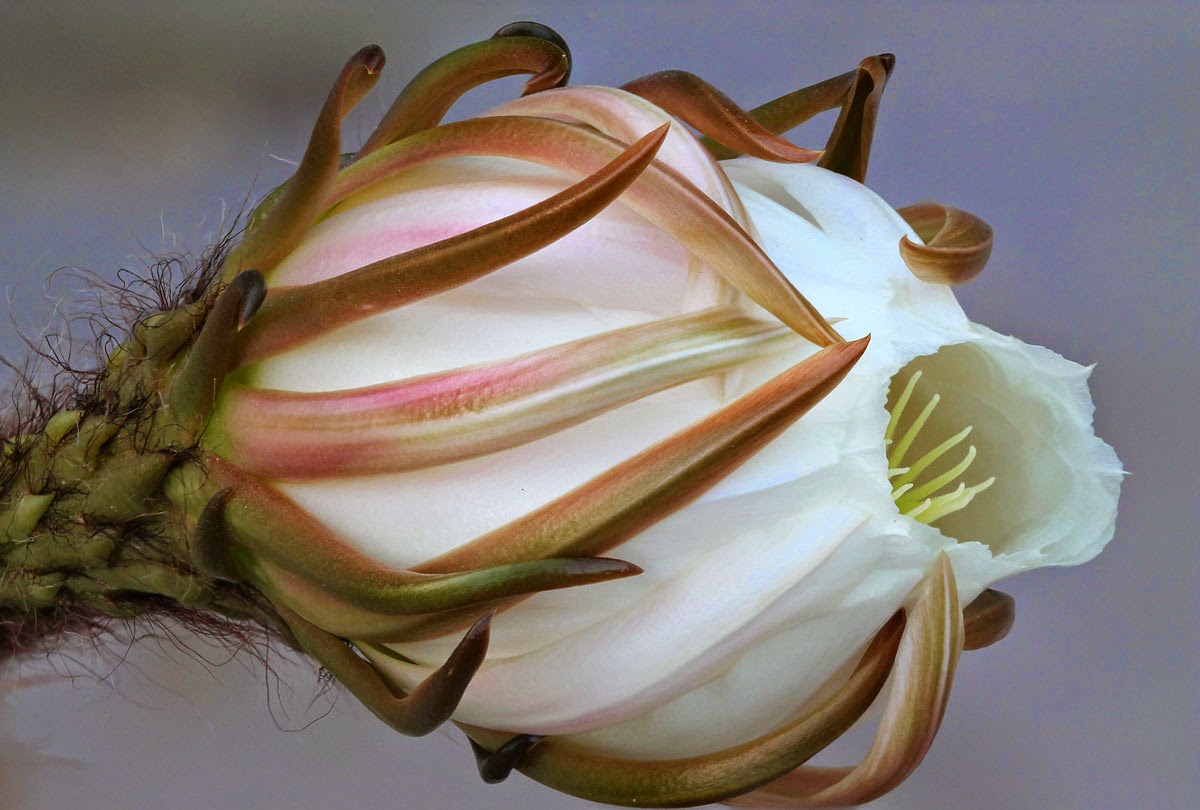 And as a demonstration as to what the original frames looked like, at left here is a single frame of the 14 used to put together the above focus stack. You can certainly see when comparing it to the final focus stack above it how much you gain from combining the multiple frames... I took another focus stack of the oblique view just afterwards, another 13-frame stack at right that keeps the entire bloom in focus - F/7.1 was my standard F/stop here to compromise light-gathering in the twilight and minimize diffraction at smaller apertures.
And as a demonstration as to what the original frames looked like, at left here is a single frame of the 14 used to put together the above focus stack. You can certainly see when comparing it to the final focus stack above it how much you gain from combining the multiple frames... I took another focus stack of the oblique view just afterwards, another 13-frame stack at right that keeps the entire bloom in focus - F/7.1 was my standard F/stop here to compromise light-gathering in the twilight and minimize diffraction at smaller apertures.
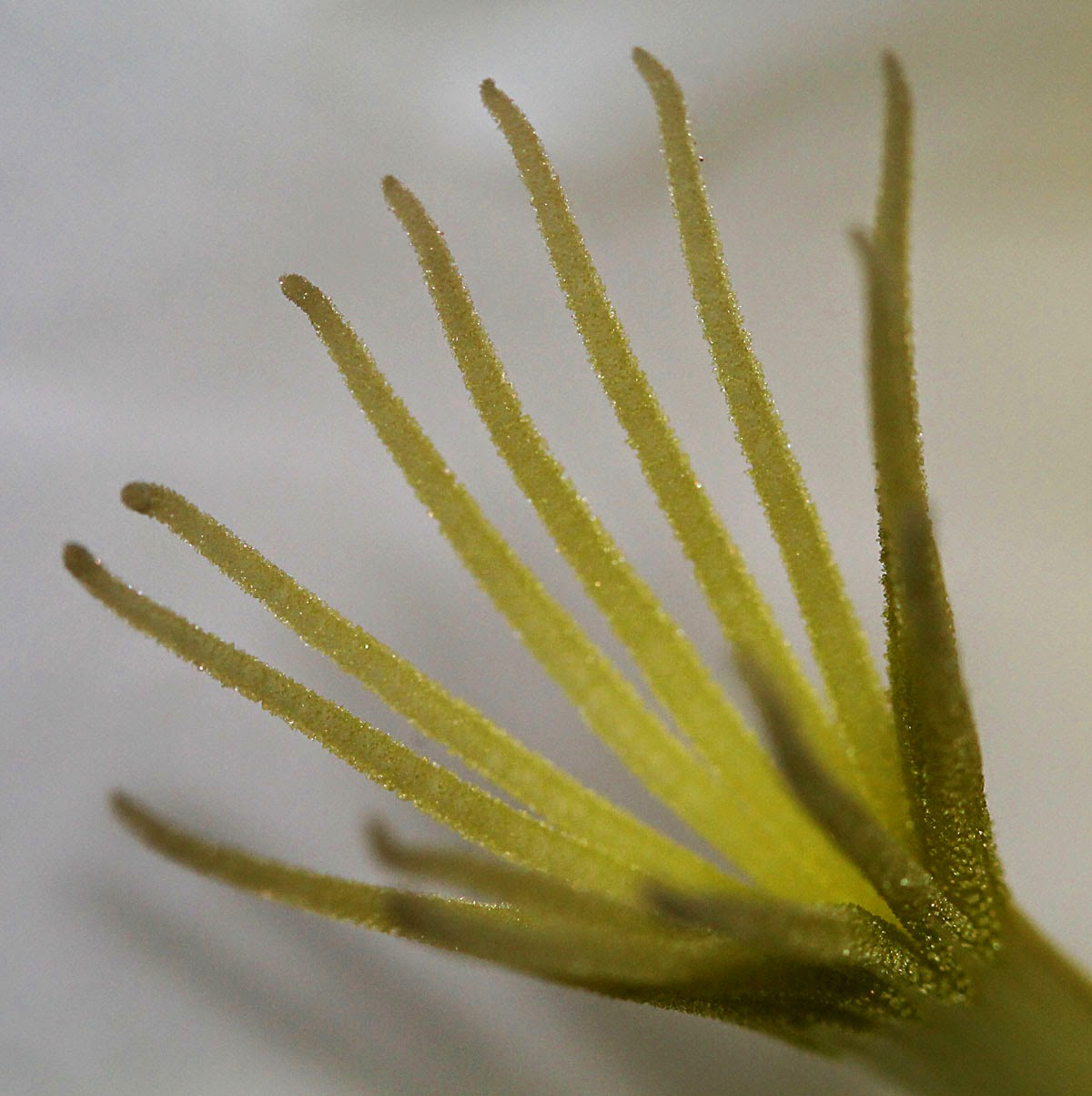 Shortly after the above, it got dark, and for subsequent shots, I was focusing and composing by flashlight - not as much fun as you imagine! Fortunately it was the day before full moon, so I didn't need too much extra light. At left, just to prove it could be done, is a focus stack of 3 frames, each 20 seconds exposure by moonlight! At right is sort of a maximum close-up I can do with the macro plus extension tubes showing some of the microscopic details of the stigma. It was a single exposure with the on-camera flash. It would, of course, benefited from focus stacking, but in total darkness, it was tough to get any sort of focus at all, let alone try to get systematic changes in focus for a series. Some other time!
Shortly after the above, it got dark, and for subsequent shots, I was focusing and composing by flashlight - not as much fun as you imagine! Fortunately it was the day before full moon, so I didn't need too much extra light. At left, just to prove it could be done, is a focus stack of 3 frames, each 20 seconds exposure by moonlight! At right is sort of a maximum close-up I can do with the macro plus extension tubes showing some of the microscopic details of the stigma. It was a single exposure with the on-camera flash. It would, of course, benefited from focus stacking, but in total darkness, it was tough to get any sort of focus at all, let alone try to get systematic changes in focus for a series. Some other time!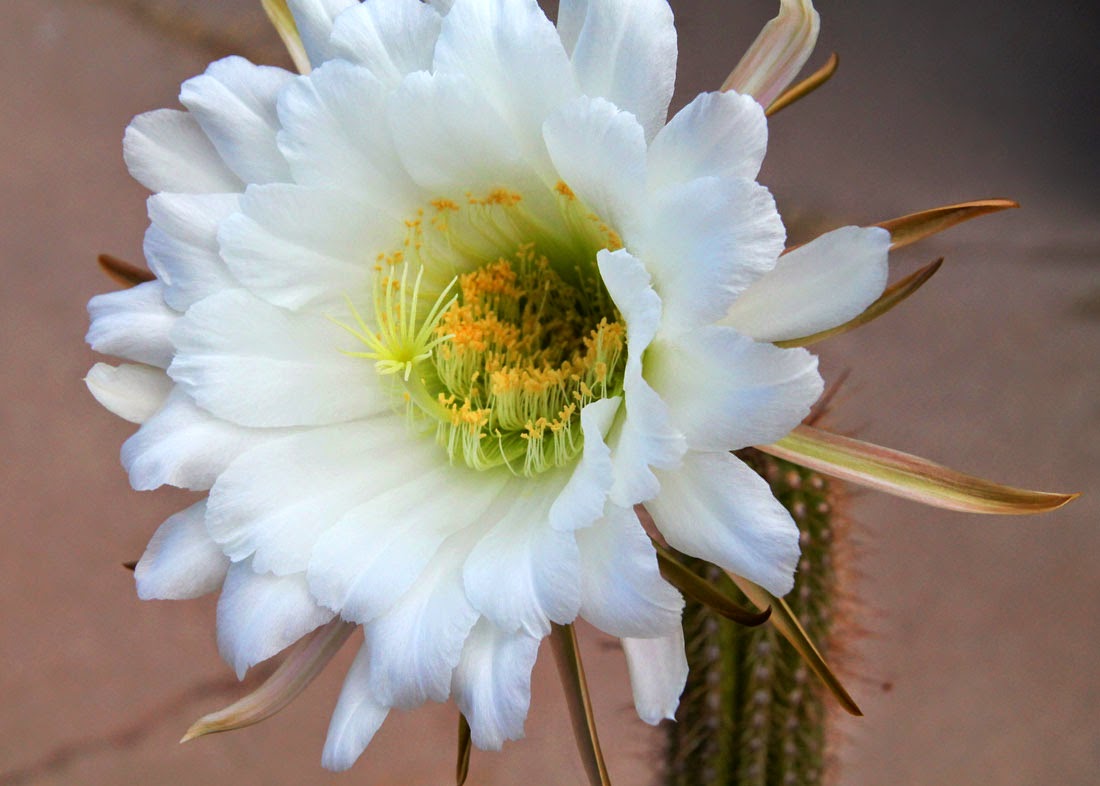 Before bedtime I checked out the flower again - appearing pretty much at full-open. While a 2-frame focus stack (at F/9 to get both flower and cactus spines in focus), failing light wasn't a reason to keep the aperture open with use of the on-camera flash. The last shot on the right taken the next morning shows not a lot of overnight changes. The flower looked pretty good, like it hadn't been visited by very many night-time pollinators. I've never seen this cactus set fruit, perhaps the pollinators aren't out this time of year, or perhaps there aren't enough of this species around to cross-pollinate. But it is always a fun subject to practice new techniques, even for the night-bloomers!
Before bedtime I checked out the flower again - appearing pretty much at full-open. While a 2-frame focus stack (at F/9 to get both flower and cactus spines in focus), failing light wasn't a reason to keep the aperture open with use of the on-camera flash. The last shot on the right taken the next morning shows not a lot of overnight changes. The flower looked pretty good, like it hadn't been visited by very many night-time pollinators. I've never seen this cactus set fruit, perhaps the pollinators aren't out this time of year, or perhaps there aren't enough of this species around to cross-pollinate. But it is always a fun subject to practice new techniques, even for the night-bloomers!EDIT: It has a name! Coworker Phil Muir suggested this cactus might be a trichocereus. I normally think of my neighbor Jack's beauty when that name is mentioned. Doing a Google image search, I found an exact replica of our potted cacti, Trichocereus spachianus, or Echinopsis spachiana





















No comments:
Post a Comment